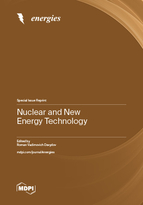Nuclear and New Energy Technology
A special issue of Energies (ISSN 1996-1073). This special issue belongs to the section "B4: Nuclear Energy".
Deadline for manuscript submissions: closed (31 August 2023) | Viewed by 16427
Special Issue Editor
Interests: mathematical modeling of physical processes; nuclear energy; nuclear magnetic resonance; control of the flowing medium; optics
Special Issues, Collections and Topics in MDPI journals
Special Issue Information
Dear Colleagues,
This Special Issue of Energies focuses on new developments in nuclear and other energy technologies.
Nuclear power is one of the most promising areas for the production of electrical energy worldwide. Nuclear power plants help to meet humanity’s ever-growing needs for the necessary power of electrical energy at any time of the day. Unlike other types of power plants, producing electrical energy at nuclear power plants does not depend on many factors, such as climate change (for hydroelectric power plants, solar installations or wind turbines) or large fuel reserves (for thermal power plants). Nevertheless, these methods of generating electricity can be successfully used with nuclear energy and separately in different situations.
There is a need to create new and improved existing technologies aimed at increasing the efficiency of electricity generation at nuclear, solar and wind power stations, as well as those aimed at meeting strict environmental safety requirements at electricity generation facilities. During the operation of nuclear power plants, special attention should be paid to processing and storing spent nuclear fuel. To do this, it is necessary to constantly conduct research, develop new technologies and carry out their modernization based on data analysis on the operation of energy facilities.
Authors working in these areas are invited to publish their work in this Special Issue of Energies.
Dr. Roman Vadimovich Davydov
Guest Editor
Manuscript Submission Information
Manuscripts should be submitted online at www.mdpi.com by registering and logging in to this website. Once you are registered, click here to go to the submission form. Manuscripts can be submitted until the deadline. All submissions that pass pre-check are peer-reviewed. Accepted papers will be published continuously in the journal (as soon as accepted) and will be listed together on the special issue website. Research articles, review articles as well as short communications are invited. For planned papers, a title and short abstract (about 100 words) can be sent to the Editorial Office for announcement on this website.
Submitted manuscripts should not have been published previously, nor be under consideration for publication elsewhere (except conference proceedings papers). All manuscripts are thoroughly refereed through a single-blind peer-review process. A guide for authors and other relevant information for submission of manuscripts is available on the Instructions for Authors page. Energies is an international peer-reviewed open access semimonthly journal published by MDPI.
Please visit the Instructions for Authors page before submitting a manuscript. The Article Processing Charge (APC) for publication in this open access journal is 2600 CHF (Swiss Francs). Submitted papers should be well formatted and use good English. Authors may use MDPI's English editing service prior to publication or during author revisions.
Keywords
- nuclear energy
- wind energy
- solar energy
- renewable sources of energy
- power management
- efficiency of electricity energy production
- ecological safety






